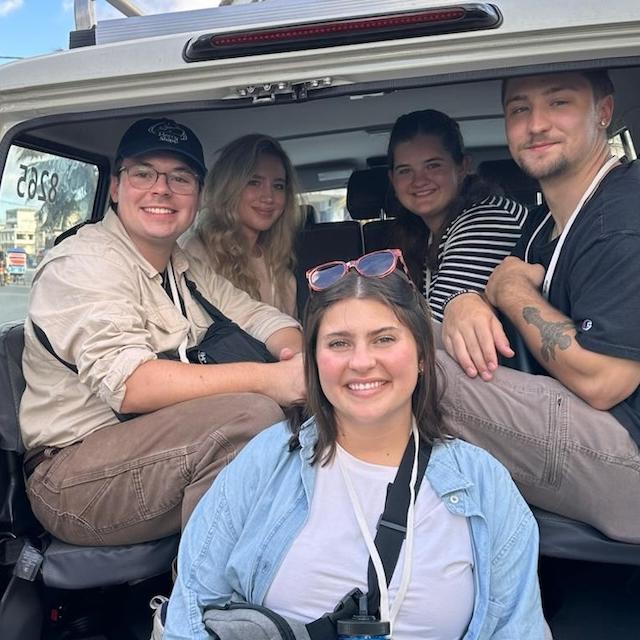
Nursing Alumnus Participates in Pilot Program with Global Health Impact
Tom Strandwitz III ’25 recently returned from a journey bringing life-changing health
services to people who otherwise might not get them. One of the lives changed was
his own.
One of only five chosen for the inaugural Student Nursing Program, the graduate of
Texas Christian University’s Harris College of Nursing & Health Sciences spent nearly
two weeks shadowing surgical caregivers and exploring strategies for outreach and
health education in communities with limited access. He contributed to helping hundreds
aboard the Africa Mercy Ship, which provides free surgical care and education for
African nations.
“In just two weeks, I met so many incredible people who all shared the same dedication
to the service of others that led me to choose nursing six years ago,” Strandwitz
said. “It was refreshing to be in a community of such singular minds and selfless
purpose in a world that seems so hopeless at times.”
Amid his days on the Madagascar-bound ship, Strandwitz penned some of his thoughts
and experiences for TCU News.
Day 1
Today was our first day on the ship, and it was certainly a whirlwind. After a ship
tour, we heard from leaders before our last activity of the day, “Deck 7 Time,” where
kids from the pediatric orthopedic ward are taken to an outer deck for fresh air.
We had a blast pulling the patients around in wagons, blowing bubbles and singing
songs in Malagasy. My biggest takeaway was how Mercy Ships’ entire mission could only
be accomplished through the selflessness and charity of everyone on board. Day 2
Day 2 started with a lesson from the palliative care team. They explained that, unfortunately,
not all patients can be operated on for myriad reasons, including terminal illness
and organ failure. Thankfully, the team is able to support those patients and their
families, both financially and spiritually, until they pass away. It was a heavy conversation
but equally beautiful to hear about the peace brought to patients in their final days.
We also visited The Hope Center on the campus of the local hospital in Tamatave, which
houses all nonlocal patients before and after their surgeries. There, we spoke with
the Hope Center director, who explained the complicated logistics of scheduling so
many patients for surgery. As someone who is interested in pursuing public health,
I was especially interested in how Mercy Ships coordinates with the health administrative
bodies in Madagascar to plan surgical schedules and patient loads based on areas of
need. This really stood out to me as it highlighted the importance of working with
a community to address health needs together.
Medical Day 1
My first morning in the hospital was spent in the rehab tent helping kids who just
had orthopedic surgery to correct Blount’s disease (an extremely severe case of bowed
legs) with their recovery exercises. I had a blast helping promote the kids’ hip mobility
and strength by kicking soccer balls with them, holding their hands while they crawled
upright, and blowing bubbles for them while they stood upright against a wall.
In the afternoon, I joined the nutrition team to learn about one of the most critical
aspects of Mercy Ships’ surgical mission: achieving and maintaining a safe weight
for surgery. This can be incredibly difficult to achieve in low-resource countries
like Madagascar, where food insecurity is often generational. It is an interesting
and important consideration that is often overlooked in popular conceptions of surgical
intervention.
Medical Day 2
My second rotation was in A ward, a combination adult-pediatric general surgery ward.
An interesting difference between Mercy Ships and a modern hospital on land is the
use of paper charting. Yes, electronic charting makes charting easier and faster but
not necessarily better for the patient. Having to think through and write down exactly
what the plan of care is, as well as write medications, assessments and education
components in multiple places, essentially forces us as nurses to be intimately familiar
with each patient’s specific situation and plan of care, something I find to be very
valuable.
Medical Day 3
Today I got to see what Mercy Ships is all about: the operating room. I got to sit
in the operating theater for several cataract surgeries. After I got over being squeamish
about seeing someone get a scalpel to the eye, I was fascinated. Mercy Ships surgeons
use and teach a manual technique to Malagasy surgeons due to the unavailability of
equipment in Madagascar and the fact that most cataract cases in Malagasy patients
are often so advanced that they would require the manual technique anyway.
The latest and greatest procedure isn’t always the best for a population, and public
health initiatives should be completed in partnership with and including input from
the target population. These lessons of humility are things I hope to take with me
as a nurse working in public health.
Medical Day 5
Today was our last day on the ship, and I was very sad to be leaving. The Africa Mercy is a shining bright spot of the stark medical reality that is global health, and
Mercy Ships continued to remind me that people are, at a basic level, humble, gentle
and kind. I had an indescribably positive experience in Madagascar, and I will certainly
be back to serve as soon as I can.
Read more about Strandwitz’s selection to Mercy Ships.
